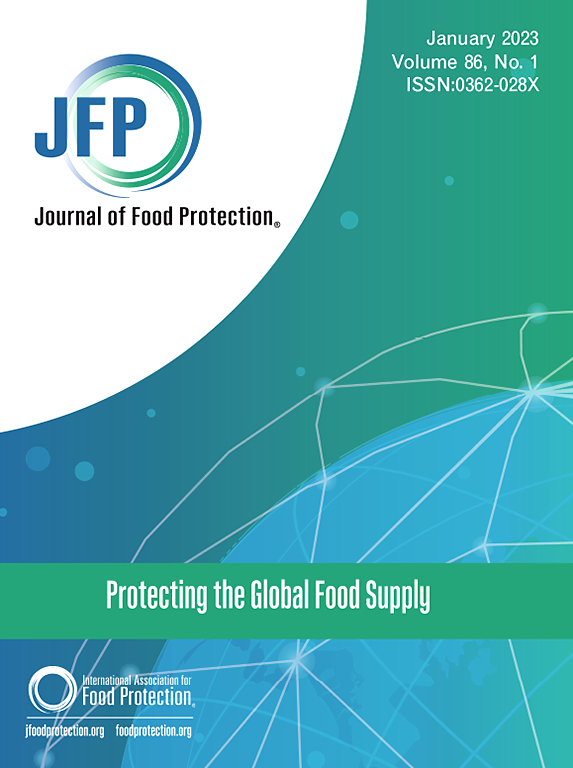Survivability of Escherichia coli O157:H7 ATCC 43888 and Enterococcus faecium ATCC 8459 in a Hydrocolloid Gel Bar Model and Macronutrient Bar Model in Response to Vacuum Microwave Drying and Storage
IF 2.1
4区 农林科学
Q3 BIOTECHNOLOGY & APPLIED MICROBIOLOGY
引用次数: 0
Abstract
This study aimed to investigate the microbial safety of Vacuum Microwave Drying (VMD) and 30 days storage at 25 °C on survivability of Escherichia coli O157:H7 ATCC 43888 and Enterococcus faecium ATCC 8459 in a nutritionally minimal bar model and macronutrient bar model. Sodium alginate hydrocolloid gel bars were inoculated with each microorganism and underwent processing in a 2 kW VMD and subsequent storage at 25 °C for 10 days in sealed bags to determine the impact of VMD on bacteria without the influence of a nutritionally dense food matrix. Additionally, the effects of macronutrient concentration on organism survivability during processing and storage were tested using a peanut butter banana bar formulated to contain high carbohydrate, high protein, or high-fat content. The macronutrient bars were inoculated with each microorganism and underwent VMD with subsequent storage at 25 °C for up to 30 days in sealed bags. Results of the hydrocolloid gel model showed that in a nutritionally minimal food matrix, both microorganisms were susceptible to VMD with additional loss of each microorganism during storage. Results showed the entire loss of E. coli O157:H7 by day 10 of storage. In the macronutrient bar study, E. faecium had minimal susceptibility to VMD and storage at 30 days while E. coli O157:H7 had minimal susceptibility to VMD with greater susceptibility to storage for 30 days. There was a significant difference (p < 0.05) in log loss comparing E. coli O157:H7 VMD processed and unprocessed bars and minimal significance comparing E. faecium VMD processed and unprocessed bars. Water activity and moisture content at storage timepoints had no observed correlation with pathogen survivability in either study.
大肠杆菌O157:H7 ATCC 43888和屎肠球菌ATCC 8459在水胶体凝胶棒模型和大量营养物质棒模型中的存活能力对真空微波干燥和储存的响应
本研究旨在研究真空微波干燥(VMD)和25℃30 d对大肠杆菌O157:H7 ATCC 43888和屎肠球菌ATCC 8459在营养最小棒模型和大量营养棒模型中的存活能力的安全性。将每种微生物接种海藻酸钠水胶体凝胶棒,在2 kW的VMD中进行处理,随后在25°C的密封袋中储存10天,以确定VMD对细菌的影响,而不受营养密集食物基质的影响。此外,在加工和储存过程中,使用含有高碳水化合物、高蛋白或高脂肪含量的花生酱香蕉棒,测试了宏量营养素浓度对生物体存活率的影响。将每种微生物接种在常量营养棒上,然后进行VMD,随后在25°C的密封袋中保存30天。水胶体凝胶模型的结果表明,在营养最少的食物基质中,两种微生物都容易受到VMD的影响,并且在储存过程中每种微生物都有额外的损失。结果显示,在储存第10天,大肠杆菌O157:H7完全消失。在常量营养棒的研究中,E. faecium对VMD和储存30天的敏感性最低,而E. coli O157:H7对VMD的敏感性最低,对储存30天的敏感性更高。差异有统计学意义(p
本文章由计算机程序翻译,如有差异,请以英文原文为准。
求助全文
约1分钟内获得全文
求助全文
来源期刊

Journal of food protection
工程技术-生物工程与应用微生物
CiteScore
4.20
自引率
5.00%
发文量
296
审稿时长
2.5 months
期刊介绍:
The Journal of Food Protection® (JFP) is an international, monthly scientific journal in the English language published by the International Association for Food Protection (IAFP). JFP publishes research and review articles on all aspects of food protection and safety. Major emphases of JFP are placed on studies dealing with:
Tracking, detecting (including traditional, molecular, and real-time), inactivating, and controlling food-related hazards, including microorganisms (including antibiotic resistance), microbial (mycotoxins, seafood toxins) and non-microbial toxins (heavy metals, pesticides, veterinary drug residues, migrants from food packaging, and processing contaminants), allergens and pests (insects, rodents) in human food, pet food and animal feed throughout the food chain;
Microbiological food quality and traditional/novel methods to assay microbiological food quality;
Prevention of food-related hazards and food spoilage through food preservatives and thermal/non-thermal processes, including process validation;
Food fermentations and food-related probiotics;
Safe food handling practices during pre-harvest, harvest, post-harvest, distribution and consumption, including food safety education for retailers, foodservice, and consumers;
Risk assessments for food-related hazards;
Economic impact of food-related hazards, foodborne illness, food loss, food spoilage, and adulterated foods;
Food fraud, food authentication, food defense, and foodborne disease outbreak investigations.
 求助内容:
求助内容: 应助结果提醒方式:
应助结果提醒方式:


